Khiva - Sheikh Mavlon Bobo Complex
Sheikh Mavlon Bobo complex was built in the XIX century in the village of Qiyot near Khiva and consists of a complex of mosques, cemetery and minarets. The cemetery here is the tomb of Shermuhammad Munis and Muhammad Rizo Erniyozbek Öghli Ogahiy. The mausoleum was renovated between 1989 and 1999. The Sheikh Mavlon Bobo complex in Khiva was restored in 1999 on the eve of the 190th anniversary of the Battle of Akhavi.

Shermuhammad Munis Khorazmiy (1778-1829) was a talented poet, painter, calligrapher, translator, historian, scholar, poet and teacher, politician. He had a wonderful “Mirob” from her life “Munisul-ushaq”, “A Friend of the Lover”, as well as “The Education of Sawodi” as a teacher and “Firdavs-ul-ikbol” as a translator.
Muhammad Rizo Erniyozbek Öghli Ogahiy (1879-1874) was one of the great exponents of 19th century literature. He was the nephew of Munis and was educated by Munis. He was a mature scholar and poet, translator and historian of the Khanate after Munis. He established a school to translate more than 20 cultures, which are considered rare masterpieces of world literature and culture. This was written in Riyad-ud-dawla (1825-1842) in 1844. “Zubdat ut-tavorikh” (1843-1846) was published in 1846, the work “Sultan Jaml” (1846-1855), written in 1856 “Davlat Gulshani” (1856-1865), a work written in 1865, (1865-1873) was written on the pages of Kokand paper in red ink on a red leather cover, the artist’s name and year, 227 pages , 14-25 cm. The piece depicted the history of Khorezm in its entirety in wars and was dedicated to the Emirate of Bukhara and the Khanate of Kokand with Russia.
With his works on the history of anarchy, he develops and promotes the traditions of Munis in this field. “Firdavs-ul-iqbol” by Munis and Ogahiy has five works on the history of Khorezm, not only the study of the history of the Uzbek people, but also the brotherly Tajiks, Kazakhs, Turkmen, Karakalpaks, Russians, and the history, culture, art, traditions, psychology of the Afghan people, the origin of these peoples, source of livelihood, etc. It is characteristic that these works have been written by the famous poet, progressive Munis and Ogahiys as they are based on the history, life, daily work, construction of mosques, madrasahs, various events, popular uprisings, life and work of great people, scholars, poets and other information described accurately and precisely.
There are 14 works by the author, of which 22 are kept in 11 copies in the College of Oriental Studies named after Beruni.
